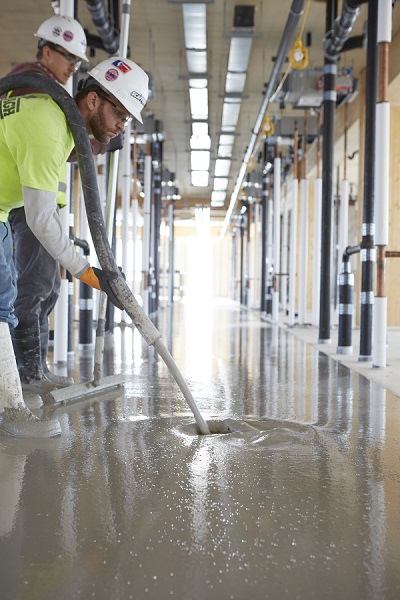Sign In
You're All Set
Welcome back! You are now signed in.
You have been logged out
You have been logged out due to inactivity
Forgot Password
Please enter the email address you used to create the account. We'll send you a link that lets you create a new password.
You're All Set
Please check your email. Click the link in the email to create a new password.
Reset Password
You're All Set
Success! Your password has been updated.
Change Password
You're All Set
Success! Your password has been updated.
Gypsum Concrete in Mass Timber Construction
Mass Timber construction is gaining popularity across the nation as a sustainable approach to building construction. While these projects champion sustainable design, there are inherent challenges that must be addressed due to the hard, wooden composition of these buildings.
Not only are acoustics and sound transmission an area of concern in floor-ceiling assemblies, but fire resistance must also be addressed. While it has become common to pour concrete as a sound and fire performance solution in mass timber structures, gypsum concrete is another poured alternative that can help reduce embodied carbon in comparison to traditional poured concrete while delivering on sound mitigation, long-lasting strength, and speed of installation.
The Weight of Embodied Carbon
The topping layer in a cross-laminated timber (CLT) mass timber structure must be 1-3 inches to achieve comparable Sound Transmission Class (STC) ratings1 as a building using standard construction methods. The necessary poured lightweight concrete topping for this type of structure would then include high levels of embodied carbon — 1,230 pounds of CO2 is produced for every metric ton of lightweight ready mixed concrete that is manufactured, according to the National Ready Mixed Concrete Association (NRMCA) Member Industry Average EPD for Ready Mixed Concrete. Embodied carbon is a measurement of the amount of greenhouse gases associated with the production of a product. Despite the beneficial lightweight properties, poured lightweight concrete contains substantial embodied carbon.

Poured gypsum concrete is a trusted solution that supports the sustainable goals of using mass timber by further reducing embodied carbon in construction. This topping layer alternative for mass timber construction can be leveraged with as little as a 1-inch pour, delivering the same sound and fire performance as poured lightweight concrete with a drastic decrease in total weight and embodied carbon—at least 75% less embodied carbon compared to conventional poured lightweight concrete.
As emerging sustainable methods of construction like mass timber make buildings more energy efficient, the focus then shifts towards specifying low embodied carbon materials as a means of lowering the overall impact of building construction on the environment.
The USG Solution
USG Levelrock® Brand 2500 Series Floor Underlayment has a lower embodied carbon value compared to poured lightweight concrete. Cement is the main binder in poured lightweight concrete, which has a very high embodied carbon due to its high-temperature manufacturing process. On the other hand, Levelrock® Brand 2500 Underlayment utilizes stucco as a binder, which is produced using a low-temperature process. As a result, the Levelrock® Brand 2500 Underlayment has a significantly lower embodied carbon value with superior sound and fire performance and shorter installation and drying times.
At a 1.4 or 1.9 mix design, Levelrock® Brand 2500 Series Floor Underlayment has an estimated 0.5 metric ton lower CO2e emissions per 1,000 sq. ft. per inch2 in comparison to poured lightweight concrete.3 For a 100,000 sq. ft. mass timber project, that equates to a reduction of roughly 50 metric tons of CO2e emissions. That is the equivalent of almost 7 homes’ energy use for one year or 12 gasoline-powered passenger vehicles driven for one year (as determined by the EPA Greenhouse Gas Equivalencies Calculator).
Replacing poured lightweight concrete with USG Levelrock® Brand 2500 Underlayment on a project is an easy substitution that results in a substantial reduction in the overall embodied carbon. If you’re looking to reduce embodied carbon in a mass timber project, reach out to your local USG rep about our innovative poured gypsum concrete solution powered by performance you can trust from the leaders in gypsum—start the conversation here.
Additional information on USG flooring solutions for mass timber construction can be found here.
References
1. McLain R, WoodWorks, MGA, Michael Green Architecture, et al. Acoustics and Mass Timber: Room-to-Room Noise Control.; 2018. https://www.woodworks.org/wp-content/uploads/wood_solution_paper-MASS-TIMBER-ACOUSTICS.pdf
2. The emissions associated with USG Levelrock® Brand 2500 Series Floor Underlayment were calculated using the Type III Product Specific EPD that is 3rd party verified.
3. The lightweight concrete emissions were calculated using the National Ready Mixed Concrete Association (NRMCA) Member Industry Average EPD for Ready Mixed Concrete.
a. From the Ready Mixed Concrete EPD, the chosen lightweight concrete had a compressive strength range of 3001-4000 psi (≥ 20% Fly Ash and ≥ 30% Slag).




